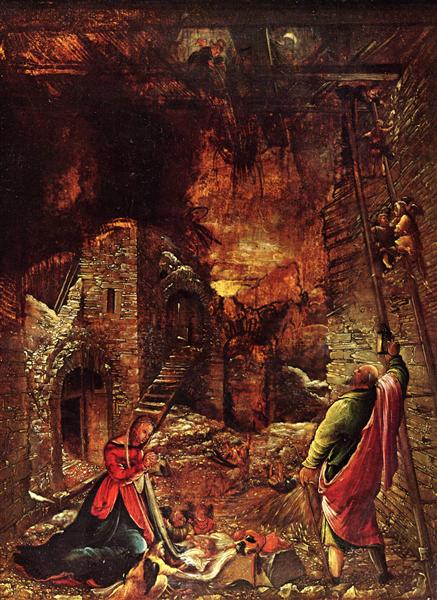Who am I? Dietrich Bonhoeffer’s Journey to the Center of the Person

Who am I?
In a poem written before his execution at Flossenbürg concentration camp, Dietrich Bonhoeffer asks ‘Whom am I? This or the Other?’ He explains how these questions constantly assail him. He ends up saying:
Who am I? They mock, they mock me, these lonely questions of mine. Whoever, I am, You know, O God, I am Yours [Letters and Papers from Prison, 448].
Notwithstanding the physical incarceration of the camp, Bonhoeffer understands that to answer the question ‘who I am?’ as a human person, I must escape the penitentiary of the ‘self.’ In other words, I cannot fully appreciate myself as a human being if I stay trapped within my own world. In a letter from 1944 Bonhoeffer notes how ‘if one has completely renounced making something of oneself…then one throws oneself into the arms of God.’ He holds that this ‘is faith; this is metanoia [conversion]. And this is how one becomes a human being, a Christian’ [Letters, 369, my emphasis]. Indeed, the martyrs to National Socialism like Bonhoeffer, the young Jesuit Alfred Delp, and Edith Stein, show how it takes only ‘a few extraordinary individuals to ward off phenomena of moral and spiritual decline in a given society’ and recapture who we are as human beings [Voegelin, Hitler and the Germans, 17]. It is quite clear that none of them were guilty of the ‘sin of abstraction’ since we see in their lives the collapse of the priority of the ‘theoretical’ and a shift towards the ‘existential.’ Unfolding within each of them are essential insights into what it means ‘to be’ a person.
Creation and Fall
Dietrich Bonhoeffer lectured at the University of Berlin during the winter semester of 1932-33. His lectures were a theological reflection on Genesis 1-3. They were published subsequently with the apparently innocent but provocative title of Creation and Fall. This was after all a time of great confusion in Germany with the collapse of the Weimar Republic and the birth of the Third Reich. During this period, Bonhoeffer encourages his young students to ‘focus their attention on the word of God as the word of truth in a time of turmoil.’ Even within the history of Christianity during the second and early third centuries there were the dangers of downplaying the Old Testament. This emerged once again during the times of the Third Reich and the rise of anti-Semitism.
In Creation and Fall Bonhoeffer focuses on the questions of who we are and our relationship with each other. He understands the person as intrinsically social. God’s identity is essentially communicated through the ‘You’ of the ‘other.’ Bonhoeffer notes how we speak of the human being as the image of God. The ‘image,’ he says, is ‘relation.’ It is a relationship of a ‘You’ to an ‘I.’ It is an ‘analogy of relation.’ The ‘likeness’ between God and humankind is ‘relationship.’ The ‘image that is like God’ is relationality and this is who God is amongst us [Creation and Fall, 64]. This is our fundamental calling as human beings. The expereince of the Fall, of course, is always a reality which entails transgressing the boundaries of who we are, forgetting our role in God’s creation. Bonhoeffer explains how:
The center has been intruded upon…Now humankind stands in the middle, with no limit. Standing in the middle means living from its own resources [its own ‘I’] …Having no limit means being alone…it no longer needs the Creator [115].
In the Hitlerian ideology this leads to the creation of the new race of ‘supermen’ or ‘new men’ who are divorced from participation in a universal humanity. We can decipher in all of this an ongoing transformation from human beings understood as created in imago Dei into imago hominis. Persons are thereby emptied of who they are and ‘dehumanized.’ As a result we are alive but, in fact, we are half-dead. In this context society hurtles easily into a world of total ‘immanence’ where there is the ‘nonexperience’ of the ‘beyond.’ But Bonhoeffer highlights how despite the broken relationship we are reconciled in Christ and recreated ‘into a new humanity’ [Sanctorum Communio, 107]. As human persons we are therefore this ‘new creation’ and ‘new humanity.’ In Jesus Christ he says ‘God became human,’ ‘human beings are set free to be truly human.’ Bonhoeffer explains how to be a Christian ‘is not something beyond the human’ but entails being ‘in the midst of the human.’ He reasons that to live as a human being before God means to live ‘not for oneself, but for God and other human beings’ [Ethics, 400].
The Priority of the Other
In light of this we can speak of ‘Jesus’s “being-there-for-others”’ and this in itself is the experience of transcendence. God makes himself one with us in Christ and restores us to our original ‘image’ as human persons, that is, in ‘relationship.’ I have mentioned already how Bonhoeffer is not guilty of the ‘sin of abstraction’ in his life or reflections. Jesus lived out the priority of the ‘other’ and faith basically means ‘participating in this being of Jesus.’ In actually ‘being there for others’ we can reestablish ‘our relationship to God’ in a new way. Bonhoeffer stresses how ‘the transcendent is not the infinite, unattainable tasks, but the neighbor within reach in any given situation, God in human form!’ In this perspective God is not a concept but ‘the human being for others!’ [Letters, 485, my emphasis]. Of course, living this out in life has a cost; it does not come to us cheaply. Bonhoeffer remarks how ‘cheap grace means grace as bargain-basement goods’ whereas ‘costly grace is the hidden treasure in the field…the costly pearl’ [Discipleship, 45]. Jesus on the cross paid the price of living the priority of the ‘other.’ God enters the world into our own time and lives with us every time we take the path of living for the ‘other’ even unto it costing our lives. Indeed, this is how Dietrich lived his life paying the costly price in his own life. He would say before his execution ‘this is the end. For me the beginning of life.’
Novel Ways of “Communion”
On Christmas Eve 1943 Bonhoeffer wrote a letter to his close friends Renate and Eberhard Bethge which was in many ways prophetic. He speaks about the experiences of separation and absence to them. He writes how:
Nothing can replace the absence of someone dear to us, and one should not even attempt to do so; one must simply preserve and endure it. At first it sounds very hard, but at the same time is a great comfort, for one remains connected to the other person through the emptiness to the extent it truly remains unfilled. It is wrong to say that God fills the emptiness; God in no way fills it but rather keeps it empty and thus helps us preserve—even if in pain—our authentic communion [Letters, 217-219].
So, for Bonhoeffer becoming truly human means acknowledging that we do not merely ‘invest the present [moment] with eternal value’ or remain just focused upon ourselves. According to his viewpoint, true ‘presence’ can be experienced also in apparent ‘absence’ leading us to search for and live in new ways of genuine communion with one another. In a letter dated August 21, 1944, he remarks how we may think ‘that our own life has meaning because this or that other person exists.’ But, in fact, we only have meaning because ‘a human being like Jesus lived.’ Had he not lived ‘then our life would be meaningless, despite all other people we know, respect, and love’ [Letters, 515]. And this is truthfully to respond to Bonhoeffer’s question ‘Who am I?’ knowing, as he says, that we are totally His.
An edited version of this article appeared in Living City, Hyde Park, NY, December 2021, Volume 60, No.12.




